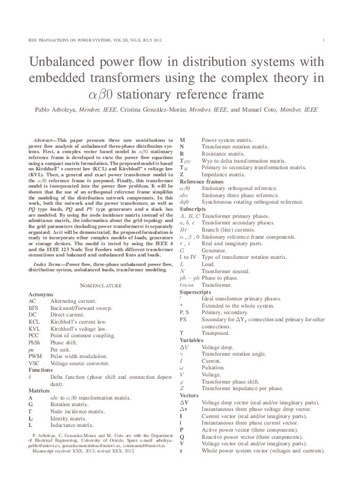Unbalanced Power Flow in Distribution Systems With Embedded Transformers Using the Complex Theory in alpha beta 0 Stationary Reference Frame
Autor(es) y otros:
Palabra(s) clave:
Three-phase unbalanced power flow
Unbalanced loads
Transformer modeling
Fecha de publicación:
Editorial:
IEEE
Versión del editor:
Citación:
Descripción física:
Resumen:
This paper presents three new contributions to power flow analysis of unbalanced three-phase distribution systems. First, a complex vector based model in αβ0 stationary reference frame is developed to state the power flow equations using a compact matrix formulation. The proposed model is based on Kirchhoff's current law (KCL) and Kirchhoff's voltage law (KVL). Then, a general and exact power transformer model in the αβ0 reference frame is proposed. Finally, this transformer model is incorporated into the power flow problem. It will be shown that the use of an orthogonal reference frame simplifies the modeling of the distribution network components. In this work, both the network and the power transformer, as well as PQ type loads, PQ and PV type generators and a slack bus are modeled. By using the node incidence matrix instead of the admittance matrix, the information about the grid topology and the grid parameters (including power transformers) is separately organized. As it will be demonstrated, the proposed formulation is ready to incorporate other complex models of loads, generators or storage devices. The model is tested by using the IEEE 4-Node and the IEEE 123-Node Test Feeders with different transformer connections and balanced and unbalanced lines and loads
This paper presents three new contributions to power flow analysis of unbalanced three-phase distribution systems. First, a complex vector based model in αβ0 stationary reference frame is developed to state the power flow equations using a compact matrix formulation. The proposed model is based on Kirchhoff's current law (KCL) and Kirchhoff's voltage law (KVL). Then, a general and exact power transformer model in the αβ0 reference frame is proposed. Finally, this transformer model is incorporated into the power flow problem. It will be shown that the use of an orthogonal reference frame simplifies the modeling of the distribution network components. In this work, both the network and the power transformer, as well as PQ type loads, PQ and PV type generators and a slack bus are modeled. By using the node incidence matrix instead of the admittance matrix, the information about the grid topology and the grid parameters (including power transformers) is separately organized. As it will be demonstrated, the proposed formulation is ready to incorporate other complex models of loads, generators or storage devices. The model is tested by using the IEEE 4-Node and the IEEE 123-Node Test Feeders with different transformer connections and balanced and unbalanced lines and loads
Identificador local:
20141904
Colecciones
Ficheros en el ítem




